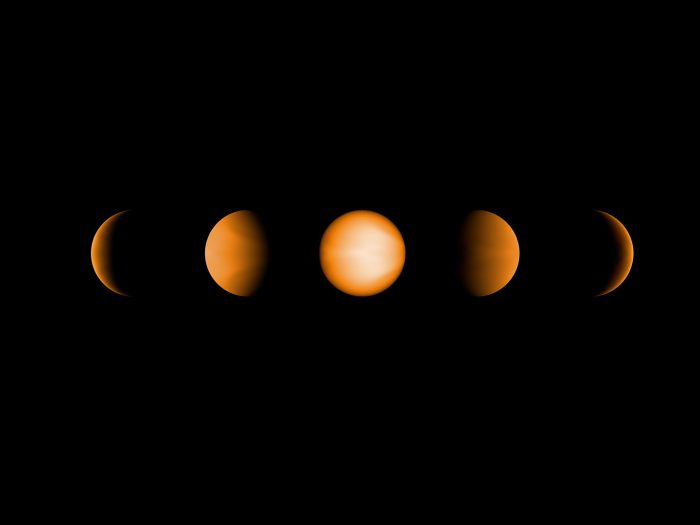Jupiter is the largest planet in our solar system.
Its immense size dwarfs everything but the Sun itself. And it lords over its own mini-system of 79 moons, not to mention various other objects affected by its powerful gravity. But this mighty gas giant is actually a bit of a kitty cat when compared to the exoplanet that you're about to meet. (An exoplanet is one found outside our solar system.) Though also Jupiter-sized, WASP 76b is anything but identical to the planet that we know.
It is closer to its star than Mercury is to our Sun. So close, in fact, that it completes an orbit every 1.8 Earth days. That's right, its year lasts about 31 hours! And being this close makes it extremely hot, too. How hot, you ask?
There's iron rain.
Hot stuff

Five different angles of WASP-76b—the exoplanet is so hot, it would glow. (NASA/JPL-Caltech/Aix-Marseille University-AMU)
Molten metal precipitation. That does sound like a very hot planet, doesn't it?
Since being discovered 640 light years away from Earth in 2016, WASP-76b has been blowing astronomers away. Even for an ultra-hot Jupiter—the name for a Jupiter-sized planet that is extremely, well, you know, hot—it really is something. And now, scientists are discovering even more surprises.
The temperatures are so extreme in its upper atmosphere, that researchers have found winds of ionized (highly charged) calcium. The likely source of this is calcium deeper inside the planet that is being evaporated. For context, calcium's boiling point (where it turns from liquid to gas) is 1484°C (2703°F).
In other words, this planet is so so so hot!
Locked and boiling
Obviously, being so close to its star—one that is a bit larger than our own Sun—is what is making it so hot. But there's more to it than just the temperature. WASP-76b is also tidally locked, which is a phenomenon that happens when an object is very close to the object that it is orbiting. It does not rotate—instead the same side always faces what it orbits.
The Moon is tidally locked with Earth. Mercury is tidally locked with the Sun. And WASP-76b is tidally locked with its star. This means that its 'day' side is taking in all of that constant heat energy and hits about 2400°C (4350°F). No wonder the winds are calcium and iron is raining from the sky! Meanwhile, the 'night' side is only around 1800°C (3272°F). Still way too hot for a holiday!
In the end, learning about this exoplanet is both fascinating and an excellent reminder of just how special our place in the universe is. Suddenly, those rainy fall days here don't seem so bad!
 Uh oh, it's raining metal again! An artist's impression of another day on WASP-76b. (ESO/M. Kornmesser)
Uh oh, it's raining metal again! An artist's impression of another day on WASP-76b. (ESO/M. Kornmesser)









